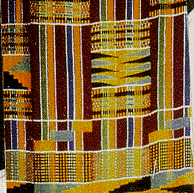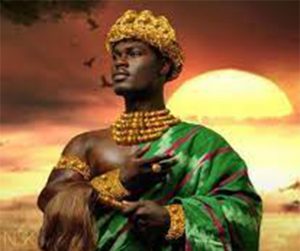What is Kente?
Kente is an Asante and Ewe ceremonial cloth hand-woven on a horizontal treadle loom. Traditionally, Kente is woven in Ghana by the Asante (Ashanti region) and the Ewe (Volta Region of Ghana).
In Ghana, Kente is made by the indigenes Akan people (including the Asante, Bono, Fante, Nzema and a dozen of other Akan sub-groups).
Kente is also produced by Ewe in Volta region of Ghana (near Togo) and Akan groups in Cote d’Ivoire, such as the Baoule and Anyin, which trace their ancestry back to Ghana before the rise of the Empire of Ashanti.
NYANKONTON
AKYEMPEM
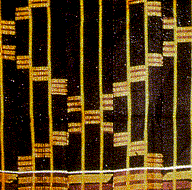
Literally means “thousands shields.” This is a reference to shields used by highly well organized militia consisting of thousands of men and women who defended the Asante Kingdom against external aggression. According to the military strategy of the Asante Kingdom, the chief of the shield bearers, the Akyempemhene, and the rear guards of the King are his own sons. Shields once used as military weapons are now used in royal ceremonies to symbolize and commemorate the military prowess of the Asante Kingdom. The cloth symbolizes MILITARY PROWESS, UNITY THROUGH MILITARY STRENGTH, BRAVERY, POLITICAL VIGILANCE & SPIRITUAL DEFENSIVENESS.
KYERETWIE
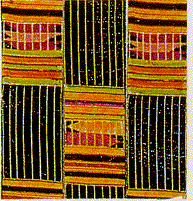
Literally means “the lion catcher.” The cloth was designed to commemorate an incident during the reign of King Kwaku Dua (1838 -1867) who tested the courage of his warriors by ordering them to catch a leopard alive. The appellation, “Kyerekwie” was since appended to the names of some of the Asante Kings whose bravery and leadership qualities were comparable to the courage needed to catch a leopard alive. The black vertical warp stripes represent the black sports in a leopard’s fur. In the past, the cloth was worn only by the Asantehene or by other chiefs with his permission. The cloth symbolizes COURAGE, VALOR, EXCEPTIONAL ACHIEVEMENT and INSPIRING LEADERSHIP.
WOFRO DUA PA A NA YEPIA WO
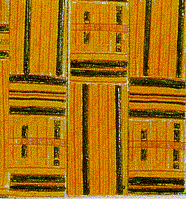
TOKU KRA TOMA
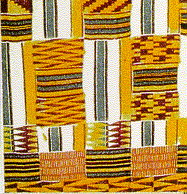
Literally means Toku’s soul cloth. The cloth is designed and named to commemorate the soul of a warrior Queenmother of that name, who, though was defeated and executed in a battle with Nana Opoku Ware I, the King of the Asante kingdom (1731-1742), was viewed as a courageous woman. It commemorates that historic event and honors the soul of that Queenmother for her bravery. In the past, such a cloth would only be worn by the royalty and people of high rank during very sacred ceremonies in which the spirits of the ancestors are venerated. The cloth symbolizes COURAGEOUS LEADERSHIP, HEROIC DEEDS, SELF-SACRIFICE, and SPIRITUAL VITALITY and REBIRTH
EMAA DA
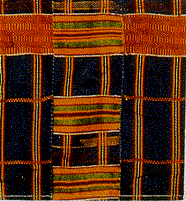
ABUSUA YE DOM
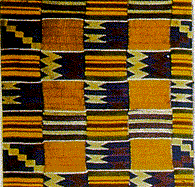
Literally means “the extended family is a force.” Among the Akan peoples, the extended family is the foundation of society. Like a military force, members of the family are collectively responsible for the material and spiritual well-being, the physical protection and the social security of all its members. The cloth was designed to celebrate and reinforce such positive attributes of the extended family system. In its many variations and background colors the cloth symbolizes STRONG FAMILY BOND, THE VALUE OF FAMILYUNITY, COLLECTIVE WORK and RESPONSIBILITY and COOPERATION.
SIKA FUTORO
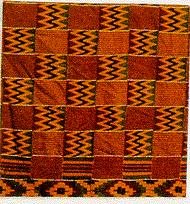
Literally means “gold dust.” Before the use of coins and paper as money, gold dust, was used as a medium of exchange among the Akan peoples and was therefore considered as a symbol of wealth and prosperity. The predominant use of intricately textured patterns in yellows, orange and reds replicate the visual characteristics of gold dust. The cloth symbolizes WEALTH, ROYALTY, ELEGANCE, SPIRITUAL PURITY and HONORABLE ACHIEVEMENT.
OBAAKOFO MMU MAN
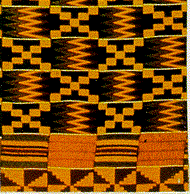
Literally means “one person does not rule a nation.” It expresses the Akan system of governance based on participatory democracy. The nine squares represent MPUANKRON (nine tufts of hair) a ceremonial hair cut of some royal functionaries who help rulers make decisions. Originally the cloth was named FATHIA FATA NKRUMA. “Fathia is a suitable wife for Nkrumah.” After the military overthrow of Nkrumah, the original significance of MPUANKRON (participatory democracy) was applied to reflect the prevailing politicalatmosphere. The cloth symbolizes PARTICIPATORY DEMOCRACY and WARNING AGAINST AUTOCRATIC RULE
ADWINASA
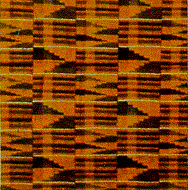
Literally means “all motifs are used up.” According to the elders, the designer of this cloth, attempted to weave a unique cloth to please the Asantehene.
In his effort he used all the motifs then known to weavers in weaving one cloth. In the end he remarked that he had exhausted all the repertoire of motifs known to Asante weavers. The cloth was, therefore viewed as one of the top quality, and the most prestigious of kente cloths, besides those woven exclusively for Asante Kings. It was in the past, worn by kings and people of high status and wealth. It symbolizes ROYALTY, ELEGANCE, CREATIVE INGENUITY, EXCELLENCE, WEALTH, PERFECTION and SUPERIOR CRAFTSMANSHIP.
In Ghana, Kente is made by the indigenes Akan people (including the Asante, Bono, Fante, Nzema and a dozen of other Akan sub-groups). Kente is also produced by Ewe in Volta region of Ghana (near Togo) and Akan groups in Cote d’Ivoire, such as the Baoule and Anyin, which trace their ancestry back to Ghana before the rise of the Empire of Ashanti. Lastly, Kente is worn by other groups in Central Africa and the African diaspora who have been influenced by Akans.
It is the best known of all African textiles. Kente comes from the word kenten in Akan language, which means basket. The Akan peoples refer to Kente as nwentoma or woven cloth.
The artist unravelled them ….woolen and silk threads which they mixed with their cotton and got many colours.” Silk was also imported into Asante from southern Europe via the trans-Saharan caravan trade. Many kente cloths, including most probably the earlier ones, utilised silk for a range of decorative techniques on a background of warp-striped cotton cloth, but some of the finest cloths prepared for royal and chiefly use were woven wholly from silk. Although since the early years of this century natural silk has been mostly replaced with artificial fibres, the artistry of Asante weavers has continued to produce remarkably beautiful cloths.
The cloths woven in the nineteenth century for the court of the Asantehene, the king of the Asante empire were probably the ultimate achievement of the West African narrow-strip weavers art. The raw material for this artistry came from Europe in the form of silk fabrics which were carefully unpicked to obtain thread which could then be re-woven into narrow-strip cloth on looms that utilised two, and in some cases even three, sets of heddles to multiply the complexity of design.
The king’s weavers were and still are grouped in a village called Bonwire near the Asante capital of Kumase, part of a network of villages housing other craft specialists including goldsmiths, the royal umbrella makers, stool carvers, adinkra dyers, and blacksmiths. Other weavers live in nearby towns. An Asante weavers’ origin myth recalls that the first weaver, Otah Kraban, brought a loom back to Bonwire after a journey to the Bondoukou region of Côte D’Ivoire.
An alternative legend recalls that during the reign of Osei Tutu the first weaver learnt his skill by studying the way in which a spider spun its web. The spider, Anansi, is an important figure symbolising trickery and wisdom in Asante folklore. Away from the court cotton weaving supplied much of the everyday dress for the Asante people, in the form of striped cloths, mostly of indigo blue and white, until it was largely displaced by wax prints and other imported textiles in the present century.
Although silk weaving would seem to have evolved locally out of the older practice of cotton cloth production, many decades of practice and experimentation would have been needed to achieve the level of complexity and technical sophistication noted in court weavers from the eighteenth century onwards. Unfortunately very few cloths that may be dated to the early decades of Asante court weaving have been preserved so it is no longer possible to document the stages of stylistic development. While the court of the Asantehene at Kumase was the wealthiest and most elaborate other subsidiary kings ruled in similar style over smaller kingdoms, replicating the regalia and rankings of the central court on a smaller scale. From the earliest times court regalia, including the rights to own and wear certain cloths, have been actively used to promote and cement the cultural unity of the diverse populations brought under Asante control.
In many kente cloths the design effect is achieved by the alternation of regularly positioned blocks of pattern in bright coloured silk with the more muted colours of the warp-striped plain weave background. Interestingly it is the background designs, the configurations of warp stripes of varying widths, that provide the basis for most pattern names. As might be expected in a culture so interested in proverbs and verbal wordplay there is a large vocabulary of pattern names still remembered by elderly weavers. Some of these names, such as Atta Birago and Afua Kobi, refer to the individuals, in these cases two Queen Mothers, for whom the designs were first woven. Others refer to historical incidents, to household objects, to proverbs, or to certain circumstances of the cloths use. When we get time we will post a page illustrating some of these design names.
The most commonly seen designs are produced by combining two distinct decorative techniques. The first, supplementary weft float, involves the addition of extra weft threads that do not form part of the basic structure of the cloth. Instead they float across sections of the ground weave, appearing on one face of the cloth over maybe six or eight warp then crossing through the warp to the back, floating there, then returning again to the top face. Rows of these wefts are arranged to form designs such as triangles, wedges, hour-glass shapes etc.
The second effect is to create solid blocks of coloured thread across the cloth strip entirely concealing the warp. Without dwelling too much on the technicalities, this effect is achieved by the use of a technical innovation unique to the weaving of southern Ghana, namely the use of a second set of heddles that has the effect of bunching together groups of warp threads allowing them to be hidden by the weft. The design of most kente cloths involves framing areas of weft float decoration within the narrow solid bands called bankuo. The finest and most elaborate examples of this style and perhaps the most spectacular cloths ever woven in Africa, completely covered the underlying warp design with alternating sections exploiting the full range of weft float designs betwen very narrow bands, producing a cloth named Adwinasa, meaning “fullness of ornament.”
Queenmothers Foundation showcases Kente to international community
Source: Daily Graphic Ghana / 14.03.2015 – With its stunning, multiple patterns of bright colours, coupled with the geometric shapes and gallant designs, Kente has been described as a unique textile and pride of Africa. ..
It has over the years played a prominent role in the world of designs and fashion. The handmade fabric, which originated from the people of the Ashanti Kingdom, has gained recognition in international circles.
Uniqueness and pride
The word, Kente, was derived from the Akan word “kenten” which means basket and is mostly produced by the people of Bonwire and Adanwomase, Sakora Wonoo, and Ntonso in the Kwabre area of the Ashanti Region. Meanwhile, some areas in the Volta Region, Togo and Cote d’ivoire are also noted for weaving Kente.
The names of Kente fabrics are usually derived from proverbs, historical events, important chiefs, and queen-mothers so there are names such as “Fathiah Fata Nkrumah, Adwenasa, Gye Nyame” and “Nyansapo”.
With the strip weaving method, young men display their skills by inventing a variety of kente patterns, each of which has a certain concept or concepts traditionally associated with it. For example, the “Obaakofoo Mmu Man” pattern symbolises democratic rule; “Emaa Da”, novel creativity and knowledge from experience; and “Sika Fre Mogya”, responsibility to share monetary success with one’s relations.
Originally, Kente was perceived to be a sacred cloth worn by Akan royals for festive occasions, but in recent times, it is worn by everyone on important and special occasions. On special occasions such as traditional wedding, engagements and special national events, the Kente has become one of the preferred fabrics for many men and women.
For instance, during the recent 58th Independence Anniversary celebration of Ghana, distinguished men and women were spotted in splendid, rich and colourful Kente, showcasing the uniqueness and pride of the Ghanaian heritage.
Kente exhibition
To show the international community the worth of the Kente cloth, an exhibition to showcase Kente and other made-in-Ghana goods to the international community has been held in Accra.
Alongside the exhibition was a mini-durbar of queen-mothers from across the country who were dressed in different patterns of pure Kente fabrics and ornaments presenting a beautiful scenery and intrinsic picture of the Ghanaian heritage.
The durbar and exhibition aimed at showcasing to the international community the rich culture and tradition of Ghana, was organised by the Queen-mothers Foundation of Ghana and the Canadian High Commission.
On display were assorted Kente fabrics and a vast array of Kente products including stoles, ties, wrappers and smocks.
The loom used to make the Kente cloth was also on display for the international community to have a firsthand experience of how the cloth is made.#
Showcasing Ghana
In an interview, the President of the foundation, Nana Serwaa Bonsu, Queen-mother of Offinso Kayera in the Ashanti Region, told journalists that the durbar was to showcase the Ghanaian heritage to the international community for them to know the finest and authentic handwoven Kente cloth.
“Our cultural heritage is rich and has so much to offer and the exhibition is to expose it to the international community. Some might have seen the Kente cloth but they do not know how it is done so it is an opportunity for them to know how the Kente cloth is woven.”
Nana Serwaa Bonsu added that the exhibition was to promote the Kente cloth and other made-in-Ghana goods, as well as attract the needed investment to the Kente industry in Ghana.
She also indicated that the durbar and exhibition was to strengthen cultural ties between Ghana and the international community.
The Queen-mothers Foundation of Ghana was established 16 years ago by selected queen-mothers from all over Ghana. As a non-profit organisation, the foundation aims, among others aims to foster excellent relationships among queen-mothers and vigorously pursue the women empowerment agenda by amplifying the good polices of the government and championing human rights.
The foundation is made up of queen-mothers from traditional areas across the country, with 84 members.
Source: Ashantibiz
Submit your stories or articles to us via WhatsApp +233-245092915


